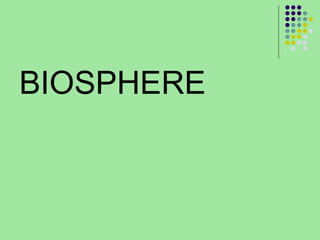
4biosphere lawtonpass-compositionearth-platetechtonics-100120123338-phpapp01
- 1. BIOSPHERE
- 2. Four Systems of Our Earth
- 3. Composition of Earth Earth Has 4 main systems that interact: Earth’s systems Atmosphere Hydrosphere Biosphere Geosphere Air/gases water life land/rock
- 4. Composition of Earth Earth Has 4 main systems that interact: The Atmosphere The Hydrosphere The Biosphere Life on Earth Sea life, plants, flying creatures, humans Encompasses hydrosphere, upper geosphere, and lower atmosphere. The Geosphere
- 5. BIOSPHERE
- 6. Living things interact with Non living things in the Biosphere Biotic Factors— living components in the biosphere Biotic, meaning of or related to life, are living factors. Plants, animals, fungi, protist and bacteria are all biotic or living factors.
- 7. Living things interact with Non living things in the Biosphere Abiotic Factors— nonliving components in the biosphere Environmental factors such habitat (pond, lake, ocean, desert, mountain) or weather such as temperature, cloud cover, rain, snow, hurricanes, etc. are abiotic factors.
- 8. Role of Water in the Biosphere Water is the universal solvent and the basis of all life on our Planet. The hydrosphere is important to the Biosphere!
- 9. Role of the Sun for the biosphere The Sun provides the light and heat necessary to maintain life on Earth and is the ultimate source of energy.
- 10. Biotic and abiotic factors combine to create a system or more precisely, an ecosystem. An ecosystem is a community of living and nonliving things.
- 12. Plants are called producers or autotrophs because they are able to use light energy to make their own food.
- 13. Animals cannot make their own food so they must eat plants and/or other animals. They are called consumers or heterotrophs. There are three groups of consumers.
- 14. To sum up: Animals that eat only plants. Animals that eat only animals. Animals that eat both animals AND plants . Humans are also omnivores!
- 15. Herbivores are animals that only eat plants or plant products (seeds). They are also called primary consumers
- 16. Carnivores are animals that eat other animals. There are 2 kinds of carnivores
- 17. Secondary Consumers are carnivores that eat herbivores Herbivores are primary consumers Something that makes its own food is called a producer
- 18. Tertiary consumers are carnivores that eat other carnivores killer whales (tertiary consumer—they eat another carnivore) Dolphin (secondary consumer—they eat a herbivore) Herring (primary consumer—they only eat plants) Photoplankton (this plant produces its own food)
- 19. Animalsand people who eat BOTH animals and plants are called omnivores WE EAT PLANTS WE EAT MEAT
